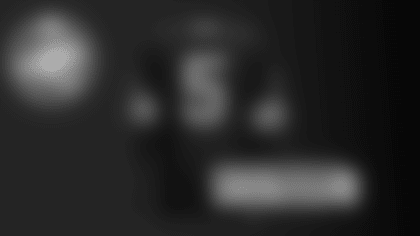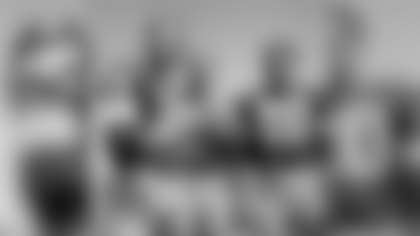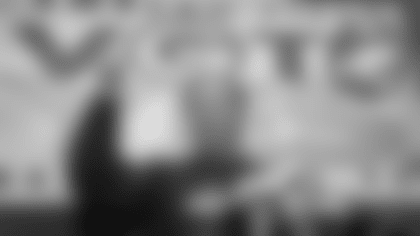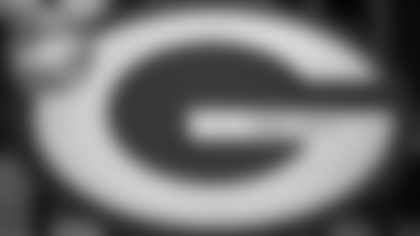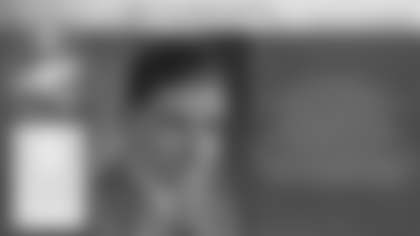Keith from Mount Pleasant, WI
I'm a shareholder and extremely disappointed in the Packer organization for disrespecting Curly Lambeau: By assigning No. 1 to Micah Parsons. I don't care if it was not officially retired. Not looking forward to the season anymore. Packers don't care about older people anymore. What next? Take Lambeau statue down for a Parsons statue?
Keith, I'm old too; maybe even older than you. But history tells me there was no good reason not to issue jersey No. 1 to Micah Parsons.
I've got two questions for you. One, have you ever seen a picture of Curly Lambeau wearing No. 1? I haven't and I doubt if one exists. Neither the Packers nor the Green Bay Packers Hall of Fame, Inc., have such a photo in their separate archives. Two, did you even know before 2002 that Lambeau once wore No. 1? I certainly didn't.
What's more, I'm all but convinced that Lee Remmel, who died in 2015 at age 90, didn't know either, at least until the last 12 years of his life, that the Packers' cofounder and early star wore No. 1.
Remmel started writing sidebars about the Packers in 1945 for the Green Bay Press-Gazette, when Lambeau was still coaching, and later worked for the team in public relations and then as its first historian from 1974-2007.
Based on what I've been able to uncover, other than including a one-paragraph note in a sidebar about Don Hutson's number being retired in 1951 and covering the press conference in 1967 when Vince Lombardi announced he was retiring Paul Hornung's number, Remmel wrote his first overview about the Packers' retired numbers in May 1968.
The story was written in response to an NFL "news 'n notes" release that included a team-by-team listing of retired numbers, which didn't include any Packers.
"… there must be some misunderstanding at 1 Rockefeller Plaza," Remmel wrote. "This accolade has been conferred sparingly in the Packers' 48-year history, but two jerseys are no longer issued. They are No. 14, worn by the legendary Don Hutson, … and the still familiar No. 5 of Paul Hornung, the highly versatile halfback who loomed large in the Pack's resurgence of the '60s."
Remmel also noted that Tony Canadeo's No. 3 had been retired but reactivated by Lombardi in 1961. Remmel made no mention of No. 1, which was worn by Lambeau for the last time 42 years earlier.
Admittedly, I can't be 100 percent certain that Remmel never wrote anything about Lambeau and No. 1 or that the Packers considered it unofficially retired, but if he did, I haven't come across it. And my educated guess would be that Remmel didn't know Lambeau wore that number until at least 2002.
That was when the Packers included an all-time list of uniform numbers in their media guide for the first time. At that point, Remmel had been working for the Packers for 28 years.
And it wasn't just Remmel.
I've yet to find where Packers cofounder George Whitney Calhoun, who wrote stories about the team for the Press-Gazette for 55 years, or Art Daley, who wrote about them for close to 70 years, ever mentioned anything about Lambeau wearing No. 1, much less noting that it had been unofficially retired or suggesting that it should be retired.
Calhoun, who was city editor of the Press-Gazette when he was named manager of the first Packer team in 1919, was still serving on the Packers' board of directors and writing a history column for the newspaper at the time of his death in 1963. Daley started covering the Packers in 1941, did so on a daily basis for 22 years and was still writing about them for Packer Report when he died in 2011 at age 94.
The subject of No. 1 and its place in Packers lore was never broached until recently, as far as I can determine. And I have at least an inch-thick file on Packers' retired numbers, including clippings from the Press-Gazette, old Milwaukee Sentinels and Milwaukee Journals, and team publications.
Keith, I'd direct your ire not at the Packers but at the those who know little about the team's storied history and promoted that nonsense through the internet and social media.
Let's first look at the history as it relates to Lambeau and jersey No. 1.
As background, when the numbers were first included in the media guide, the preface stated it was compiled with the help of the Pro Football Hall of Fame and started with the 1925 season, probably because the hall doesn't have any Packers' regular-season programs pre-1925. Thus, the list in our current guide still starts with 1925.
But I've been able to find numerical rosters in Packers publications and game programs for at least one league game from 1921-24, as well.
Keep in mind, there's no guarantee that players actually wore the number listed in the program for every game and there's no film or even black-and-white game photos to confirm numbers from Lambeau's playing days. In fact, it wasn't until 1929 that the Packers wore numbers on the front of their jerseys. Thus, even team photos from 1921-28 are of no help.
Lambeau wore No. 1 in four of his nine league seasons: 1923-1926.
He also wore No. 10 in 1921, based on The Dope Sheets, the Packers' official publication, for the team's four home league games that season. In 1922, Lambeau was listed as wearing No. 13 in the program for the Oct. 22 game at Milwaukee, and No. 22 for the Nov. 5 home game against the Columbus Panhandles.
In 1927, he's listed as wearing No. 14 in the programs for home games against the Chicago Bears and Duluth Eskimos. In 1928, his number was 42, based on programs for the first four home games against the Frankford Yellow Jackets, Bears, New York Giants and Chicago Cardinals.
In 1929, his final season as a player, he was listed as wearing No. 20 in home programs for games against the Dayton Triangles, Bears and Cardinals, as well as the season finale against the Bears in Chicago.
A picture also exists of him wearing No. 18, although I found no evidence that he wore it in a league game.
Thus, it appears as though Lambeau wore at least six other numbers in regular-season games: 10, 13, 22, 14, 42 and 20. Although he didn't appear in any games in 1930, Lambeau was listed again as wearing No. 20 in at least two programs. Perhaps he coached that season – or at least in some games – wearing a uniform.
Obviously, No. 1 wasn't part of Lambeau's identity as a player. Certainly not like Bart Starr wearing No. 15 over 16 seasons; or Brett Favre and No. 4 or Aaron Rodgers and No. 12.
Also, at least two other Packers wore No. 1 before Lambeau: tackle Cub Buck, the Packers' first big-name player who had been a teammate of Jim Thorpe's with the Canton Bulldogs and in 1950 was named one of the two greatest tackles of all-time by Thorpe; and halfback Eddie Usher in 1922.
Now, let's look at the history of players wearing No. 1 throughout the NFL.
Based on a listing at the Pro Football Reference website, a total of 212 players have worn No. 1. Of those, 48 players wore it in the 1920s and 69 started wearing it in the 2020s. That's 55 percent of the total.
The fact is that from Lambeau's last season through 1969, a span of 40 years, only 22 NFL players wore No. 1, including a mere five during the 1950s and '60s.
According to Joel Bussert, an NFL administrator for 40 years and now its unofficial historian, the league adopted a numbering system for the first time in 1952 that allowed only quarterbacks to wear a number from 1 to 19. The numbers for the other positions were: halfbacks, 20-29 and 40-49; fullbacks, 30-39; centers, 50-59; guards, 60-69; tackles, 70-79; and ends, 80-89.
By the way, that's contrary to the "History of NFL Jersey Number Rules" posted at operations.nfl.com and also in the 2025 NFL Record and Fact Book Chronology. Both state that "a jersey numbering system was adopted" in 1973.
But Bussert is correct.
In 1973, the rule was tweaked, allowing kicking specialists to wear numbers from 1 to 19, as well. By that point, almost all teams were carrying kickers and punters on their rosters, and no longer relying on position players to handle those duties.
Thus, from 1952-72, only four Packers wore a single-digit number: Canadeo and Ben Agajanian, No. 3; Hornung, No. 5; and Bob Forte, No. 8.
Agajanian, a 42-year-old kicker who started playing in the NFL in 1945, was signed as an emergency backup when Hornung was called up for service duty in 1961. Hornung was drafted as a quarterback and given No. 5 in 1957. And Forte, who had worn No. 8 since 1946, continued wearing it in 1952 and '53, his final two seasons.
From 1973 through 2019, a span of 46 seasons, a total of 36 Packers wore single-digit numbers.
2 – Mason Crosby, K, 2007-22; 4 – Chuck Fusina, QB, 1986; Dale Dawson, K, 1988; Favre, 1992-2007; 5 – Vince Ferragamo, QB, 1986; Willie Gillus, QB, 1987; Don Majkowski, QB, 1987; Curtis Burrow, K, 1988; 6 – Ryan Flinn, P, 2005; Graham Harrell, QB, 2012; Joe Callahan, QB, 2017; JK Scott, P, 2018-20; 7 – Dick Gordon, WR, 1973; Majkowski, 1988-92; Sean Landeta, P, 1998; Chris Hanson, P, 1999; Danny Wuerfel, QB, 2000; J.T. Sullivan, QB, 2004; Ingle Martin, QB, 2006; Jeremy Kapinos, P, 2008-09; Brett Hundley, QB, 2016-17; 8 – Max Zendejas, K, 1987-88; Anthony Dilweg, QB, 1989-90; Mark Brunell, QB, 1994; Ryan Longwell, K, 1997-2005; Tim Masthay, P, 2010-15; Justin Vogel, P, 2017; Tim Boyle, QB, 2019-20; 9 – Dean Dorsey, K, 1988; Bryan Wagner, P, 1992-93; Dick Borgognone, K, 1995; Jim McMahon, QB, 1995-96; Josh Bidwell, P, 2000-03; Bryan Barker, P, 2004; Jon Ryan, P, 2006-07; Seneca Wallace, QB, 2013; DeShone Kizer, QB, 2018.
The increase in numbers was not only due to the 1973 rule change, but roster limits that had increased from 40 to 53 and training camp limits that had ballooned from 60 to 90.
The only player among those 36 who wasn't a quarterback, kicker or punter was Gordon, then with his third team and in the second-to-last season of a 10-year career. Claimed on waivers before the final six games in 1973, Gordon requested No. 5, but equipment manager Dad Braisher refused to give it to him because Lombardi had retired it.
Otherwise, the list included 17 quarterbacks, including Majkowski, who wore No. 5 as a rookie and switched to 7 out of respect for Hornung, once he learned that his number had been retired; along with 11 punters and seven kickers.
Notice also that only eight players on that list were given a number from 1 to 5.
No Packer wore No. 2 from 1927 when Charlie Mathys, a Green Bay native and the Packers' first established quarterback, retired until Crosby in 2007, a span of 80 seasons. And only Fusina and Dawson, who appeared in a total of 11 games, wore No. 4 from blocking back Herm Schneidman's last season in 1937 until Favre's arrival in 1992, a stretch of 55 seasons.
In truth, No. 1 wasn't treated much different than Nos. 2 and 4. Both Nos. 3 and 5 were considered to be retired, although coaches Forrest Gregg and Lindy Infante issued 5 to three players who wore it for a total of five games, plus Majkowski, who appeared in seven games as a rookie.
It's also worth noting that of the 36 players who wore single-digit numbers over those 46 seasons, only Crosby, Majkowski, Longwell, Masthay and Bidwell had them for more than three seasons. Twenty-one of the 36 lasted no longer than one season with the Packers.
Basically, single-digit numbers were given to fringe quarterbacks and kicking specialists who didn't figure to be around for very long.
The recent and huge increase of single-digit numbers across the league was the result of a 2021 rule change that now allows all players except linemen to wear them. Wide receivers, tight ends, halfbacks, fullbacks, H-backs, linebackers and defensive backs can now wear numbers from 1 to 19 in addition to quarterbacks, kickers and punters. Another rule change in 2023 also opened the door for more players to wear 0.
The 2021 rule change was what allows Parsons to wear No. 1. He was classified as a linebacker when he entered the league.
In essence, for almost 50 years, prior to 2021, teams could only issue single-digit numbers to two, or maybe three, quarterbacks, plus a kicker and a punter. In other words, four total, maybe five. That's arguably the main reason the Packers didn't issue No. 1 for nearly 100 seasons. Only so many players were eligible to wear it.
This season, on cutdown day to 53 players, 32 Packers were eligible to wear No. 1.
Scott from Seabrook, TX
I'm a lifelong Packer fan and recently became intrigued by Johnny Blood. In what seems to be his most famous picture he is wearing a No. 27 jersey. But everything I've read says he wore: No. 14, 1933; No. 20, 1931-32; No. 24, 1929-30; No. 26, 1935; No. 55, 1936; No. 15, 1937- 38 with Pittsburgh. I would like to have a jersey made with his name on the back. What number would you choose?
I'd go with No. 24. That's the number he wore in his first season with the Packers and also for the first two of their NFL record three consecutive championships from 1929-31.
Blood is a good example of how often some players switched numbers in the 1920s and into the 1930s. Much like Lambeau, Blood clearly had no particular attachment to a specific number.
I would not choose No. 27, even though you are correct that's the number you see Blood wearing in what is probably the most-published picture of him. But from what I've found, there's no evidence he ever wore 27 in a game.
That picture first appeared as a solo shot in the Packers' 1929 programs, although he wore No. 24 in that year's team photo and that was the number listed for him in programs.
So what's the story behind him wearing No. 27?
I just discovered in my latest research efforts that seven different Packers were wearing No. 27 when their individual photos were taken for the 1929 programs. Blood was one of them.
Why?
I don't know. The Packers got new uniforms that season – their yellow or gold jerseys with the small blue numbers encircled in the front – and my suspicion would be that the players maybe just grabbed a few to pass around when their individual photos were taken. Seven players were also photographed in No. 32 and five in No. 36. In other words, 19 of the 24 players pictured in the program for the Sept. 15, 1929, preseason game against the Portsmouth Spartans were wearing one of three numbers.
And kudos to you for getting Johnny Blood's name right.
Kenneth of Fort Collins, CO
Do you suppose Micah Parsons knows the history of No. 1? Pro Football Reference shows numbers 14, 42 and 20 associated with Lambeau. Apparently, he wasn't particular at the time. Lambeau's positions are shown as TB-FB-BB-E.
Parsons seems to have embraced the significance of the Packers' storied history, and my guess would be that he was told or read somewhere that he's the first Packer to wear No. 1 in a game since Lambeau.
As you stated, Lambeau didn't appear to be particular about his number. Again, that's why I'm puzzled over any fan being upset with Parsons wearing No. 1.
No. 10 was the first number Lambeau wore when the Packers entered what was then the American Professional Football Association. No. 20 was his number in the Packers' first championship season and his last as a player.
True, Lambeau wore No. 1 more than any other. But who's to stay he cherished that number any more than 10 or 20 for their historical significance?
As for Lambeau's positions, he appeared in 77 NFL games and started 49, 35 of them at right halfback. He also started seven at quarterback, six at fullback and one at left halfback.
I use Pro Football Reference often, but based on the positions it lists for players when Lambeau used the Notre Dame Box from 1921-46, it's obvious its staff has little understanding of that offense and especially Lambeau's version of it.
For one, there was no tailback in Lambeau's Notre Dame Box – nor do I believe in Knute Rockne's – and duties of the left and right halfback were interchangeable based on the pre-snap shift that was the feature of the offense. Unlike in the single wing, Lambeau could run his offense through any of the four backs.




